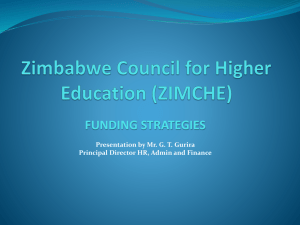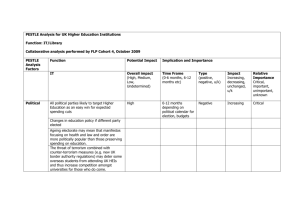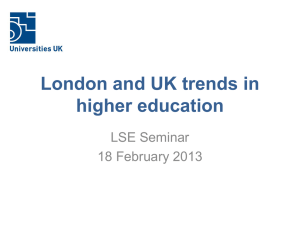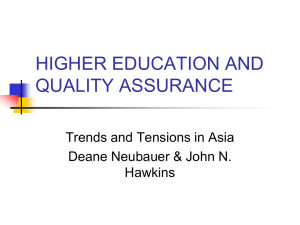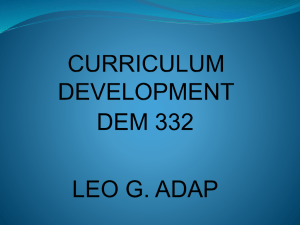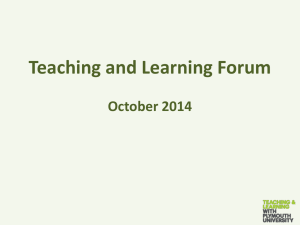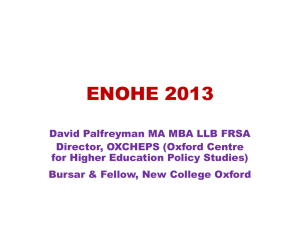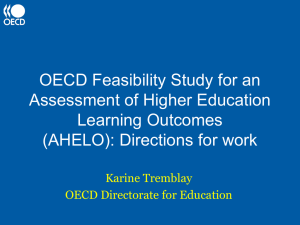OECD/IMHE programme on Supporting the Contribution of HEIs to Regional Development
advertisement
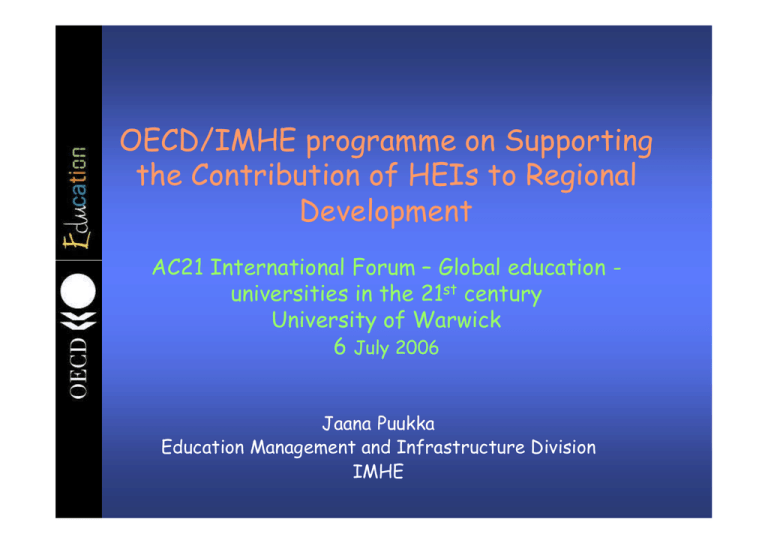
OECD/IMHE programme on Supporting the Contribution of HEIs to Regional Development AC21 International Forum – Global education universities in the 21st century University of Warwick 6 July 2006 Jaana Puukka Education Management and Infrastructure Division IMHE Objectives of the Programme • Response to initiatives across OECD to mobilise HE in support to regional engagement (e.g. NURI and RIS in South Korea, HEIF in UK) • Synthesise experience into coherent body of policy and practice to guide HEIs and regional and national governments • Provide opportunity for dialogue btw stakeholders and help with clarification of roles and responsibilities (i.e. assist with capacity building in each country/region) Participating regions 14 regions in 12 countries, including one crossborder region Regions • 14 regions (in 12 countries) which opted into the programme i.e. not a pre-determined selection • Criteria – nationally recognised administrative region with some history of working with HEIs • All HEIs operating in regions to identify division of tasks plus their key partners • Wide variety of regional and national contexts and types of HEIs • • • • Metropolitan Central Research intensive Devolved countries rural peripheral vocational centralised Participants • • • • • • • • • • • • • Denmark (Jutland-Funen) Finland (Jyväskylä region) England (the North East) Spain (two regions: Valencia and the Canary Islands) Sweden (Värmland) The Netherlands (Twente) Norway (Mid-Norwegian Region) Australia (Sunshine-Fraser Coast) Korea (Busan) Mexico (Nuevo León) Denmark-Sweden (The Øresund region) Canada (Atlantic Canada) Brazil (North Parana) Methodology • • • • • • Common framework for regional selfevaluation developed by OECD task group Self-evaluation report by regional consortium using OECD guidelines Site visit by international peer review team (HEI, Regional, National Experts) Peer Review Team review team report and response from the region Analysis and synthesis by OECD task group drawing upon regional case studies and commissioned review of literature Production and dissemination of synthesis report Self-Evaluation Report 1) 2) 3) Regional context Regional/national higher education systems Contribution of research to regional innovation 4) Contribution of teaching and learning to labour market and skills 5) Contribution to social and cultural development and environmental sustainability 6) Contribution to regional capacity building Progress since August 2005 • 14 reviews fixed in terms of team members, review dates and funding. • 12 review visits completed: the last 2 will take place in autumn • 11 self-evaluation reports available and disseminated to other regions (NE England, Twente, Värmland, Öresund, Busan, Jyväskylä, Sunshine-Fraser Coast, Mid-Norway, JutlandFunen, Canary Islands, and Valencia). 1 more to come up shortly (Nuevo León) . • The first 6 Peer Review Reports available (NE England, Busan, Twente, Värmland, Jyväskylä, Sunshine-Fraser Coast). 6 more to be published by end-July Sources of research-based evidence Within Directorate for Education Education and Training Policy Division: Evaluation of Tertiary Education Education and Equity Within Directorate for Public Governance and Territorial Development (GOV): - Territorial reviews IMHE Commissioned paper: Understanding the regional contribution of HEIs, a literature review Regional SelfEvaluation Reports Peer Review Reports Research based evidence Final Synthesis Report Dissemination • International seminar on the role of higher education institutions in regional development, Karlstad University, Sweden, 3-5 Oct 2005 • Wrap-up Conference for participating regions Copenhagen, 16-17 Oct 2006 • International Launch Conference Valencia, Sep 2007 • Country-related dissemination seminars What have we learnt so far… To become globally competititive OECD countries need to invest in the regional innovation systems Innovation-led growth: four pathways Indigenous creation of new industry - Create entirely new industry Exogeneous creation of new industry Diversification of existing industry into new Upgrading existing mature industry - Import new industry to the region - Use the core technologies of an existing and declining industry - Enhance products, services or production technologies In Castellon, Valencia, Universidad Jaime I is recognised as a world leader R&D in the tile industry. It has helped to transform the region’s traditional industry. The growth is built on technology transfer, spinoffs and upgrading of existing technologies. – Today, Valencia is a global leader in the tiles industry. Source: the Valencia Region SER …there are other types of contributions, too… … Consider Wider Approaches to HE’s contributions In Central Finland, Jyväskylä University of Applied Sciences has helped to rehabilitate 800 long term unemployed back to working life with a wide range of physical and social rehabilitation measures, partly delivered through the student training centre. Source: The Jyväskylä region SER In the North East of England, the 5 HEIs use sports as a means to widen access to HE, to raise aspirations and to enhance social cohesion within the excluded communities. Source: the NE England SER In Mexico, all university students are obliged to do 480 hours community work Source: the Nuevo Leon SER What else? • Abundance of action based on generic growth in most regions, but a lack of systematic processes and limited cooperation among HEIs and btw HEIs and stakeholders • Focus on research, technology transfer, businessrelated competitiveness • Contribution to social, cultural and environmental development and ”knowledge transfer on legs” i.e. the students’ role often neglected • HEIs’ role as ”good citizens” not yet embraced • Widening access, Life Long Learning, and equity issues often neglected • Common challenge: What to do with lowtech SMEs? What is stopping the HEIs? Regional development a contested terrain. - Create joined-up government HE Acts with requirements for 3rd role, but no incentives, indicators or systematic monitoring of outcomes - Review funding streams to add incentives Tensions btw regional engagement and academic excellence -Showcase best practice examples - Create incentives for individuals Thank you For more info see www.oecd.org/edu/higher/regionaldevelopment or contact jaana.puukka@oecd.org Project Manager
